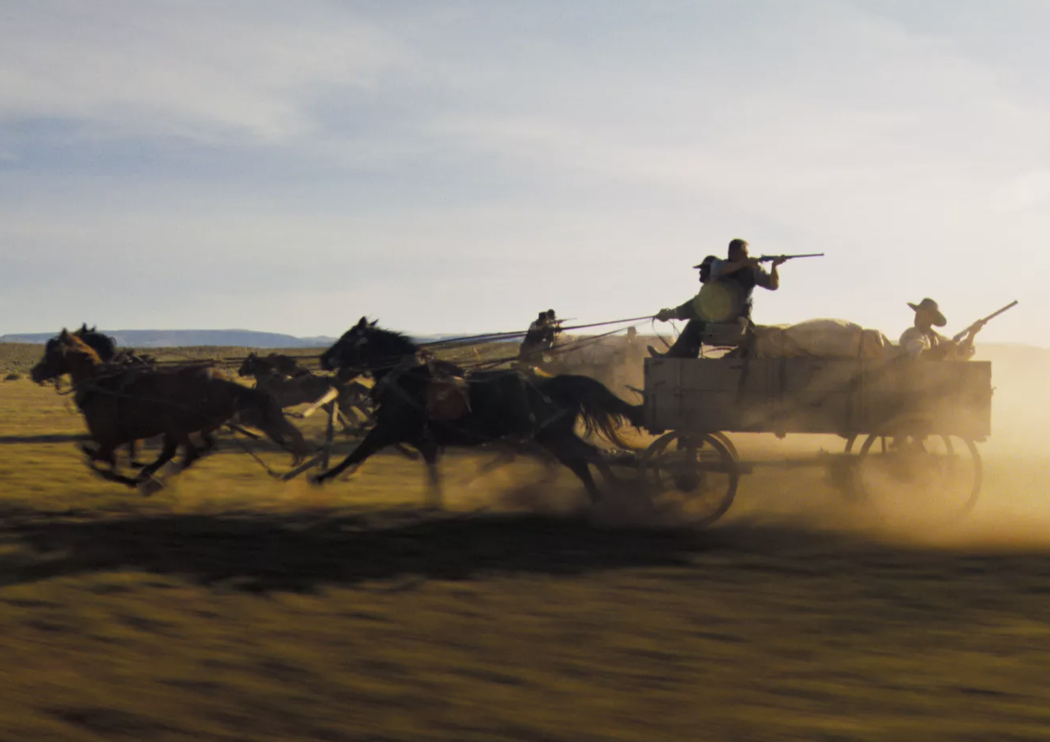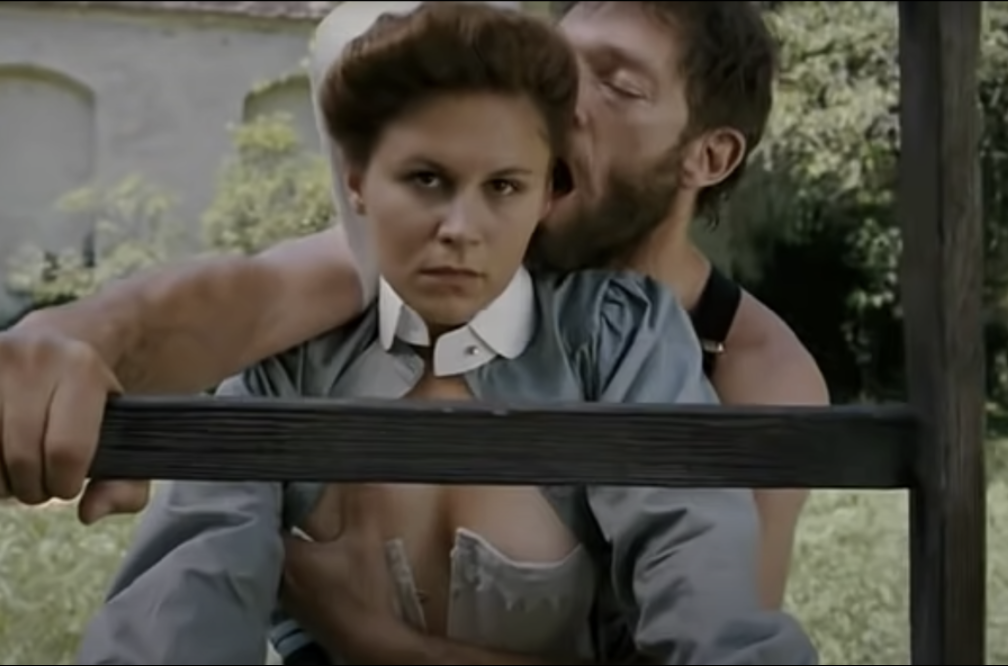Strange Invaders
There’s no telling how good or even credible Timothy Hines’ screen adaptation of H.G. Wells’ The War of the Worlds will be, but it’s hard not to sympathize with any David facing a Goliath…especially when the kid with the slingshot got rolling on his project first.
Hines’ film cost $12 million and apparently has no formal distributor, but will open, it is being claimed, seven and a half weeks from now — on Wednesday, March 30 — in five major cities on a four-wall basis…or so I’ve been told. (Hines is claiming he has a distributor, although he won’t identify it.)
Paramount Pictures War of the Worlds (6.29), which is costing at least $150 million to produce, boasts the talents of director Steven Spielberg, star Tom Cruise and screenwriter David Koepp. Nonetheless, it will open about three months after the indie upstart.
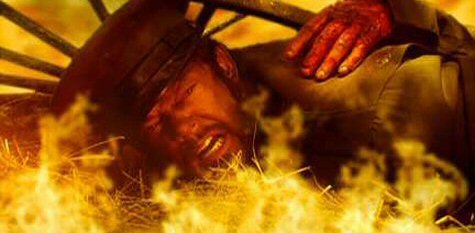
A turn-of-the-century English military man (James Lathrop) enduring an attack by Martian invaders in Timothy Hines’ modestly-budgeted version of H.G. Wells’ The War of the Worlds.
No one thinks this will have even a slight effect upon the grosses of the Spielberg film, but the timing of the release of Hines’ film could work in his favor.
The notion of a Seattle-based, hip-pocket filmmaker beating Spielberg, Cruise and Paramount Pictures to the Martian punch is, at the very least, intriguing.
As Hines told me yesterday over the phone, “I’m not doing this on the coattails of Spielberg. I’ve been working on this film for seven years. We almost made it two years ago but 9/11 forced us to rewrite it and start over. In any event we’re not selling sizzle — we actually have the steak.”
< ?php include ('/home/hollyw9/public_html/wired'); ?>
And yet there are issues about the Hines project that are giving me concern.
For one thing, the 44 year-old Hines (House of the Rising, A Midsummer Night’s Dream) won’t tell me who his financial backers are, except to describe them as “computer industry people, and I’m not talking about Paul Allen or Bill Gates.” He said one of the individuals behind the project is “one of the largest venture capitalists in the world.”
Then there’s the issue of Hines declining to tell me who his distributor is. I was told Friday morning that he doesn’t actually have one — he and his partners are going to self-distribute (i.e., “four wall”) by booking screens outright, paying for their own advertising, etc. Hines has since declared this is “not true,” although he wouldn’t cough up specifics.
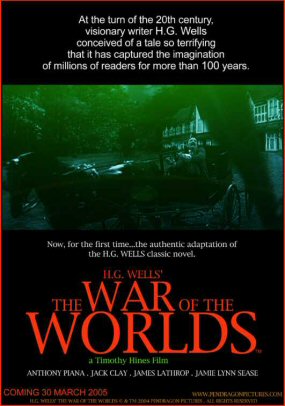
The one-sheet for Hines’ film looks half-classy, half-exploitation…passable but a little bit cheesy-looking. It’s not the sort of movie poster, I would think, that a savvy, hard-core distribution marketer would necessarily use to sell a movie with. Is this reflective in some way of the film itself?
Hines, the head of a Seattle-based company called Pendragon Pictures, has been doing a fairly skillful job of promoting his film on at least two websites aimed at sci-fi geeks, but it bothers me that the trailer won’t play, and is viewable only via Windows Media.
(Hines wrote me after this article posted on Friday and insisted “the trailers on howstuffworks.com are perfectly downloadable and have been downloaded by millions.” Good to hear…but I couldn’t download them, and a screenwriter friend who lives in New York had the same experience.)
Hines’ feature, an apparently faithful adaptation of Wells novel that’s set in 1900 England, cost a reported $20 million, although $8 million of this was sunk into an earlier version that was going to be set in the present day, but was abandoned after the 9.11 tragedy. (It was decided that a modern-day film about invading destructive Martians would seem exploitive.)
H.G. Wells’ The War of the Worlds, the official title of Hines’ project, may turn out to be a half-decent low-budgeter, a surprisingly inventive film or a grade-Z stinker, but come hell or high water it is apparently set to open in Atlanta, New York, Chicago, Seattle and San Francisco on 3.30.
A follow-up DVD release is set for 6.15 — two weeks before the Spielberg-Cruise flick hits screens.

Mechanical, spider-like Martian menace in H.G. Wells’ The War of the Worlds.
Whatever else it may turn out to be, the Spielberg-Cruise War of the Worlds is expected to be an all-out, go-for-broke CG extravaganza. It’s a modern-day spin on Wells’ allegorical tale of alien invaders (i.e., it was meant as a metaphor for British colonialism, and was actually a kind of protest about the Boer War), and will be set largely in and around Hoboken, New Jersey, with Cruise apparently playing a longshoreman.
It wouldn’t be totally out of line in a present-day context to call the Spielberg-Cruise flick a metaphor about U.S. invasion and occupation of Iraq — just think of U.S. forces as the Martians and the Iraqis as Hoboken natives.
I called around yesterday (i.e., Thursday) and found it hard to find anyone in the indie distribution community who’s seen Hines’ film, or has spoken to anyone who’s seen it.
Hines told me a story about the film’s release strategy and financial backing was expected to break in Forbes on 2.11, but I checked about this on Friday morning and it appears that the story may be delayed.
I asked Hines why his pre-release strategy didn’t involve a trade story or two in Variety or The Hollywood Reporter. He didn’t have much of a response other than to air a suspicion that trade magazine reporters are too caught up in catering to powerful Hollywood distributor-advertisers to deliver an unbiased report about a small-time producer going up against the big guys.
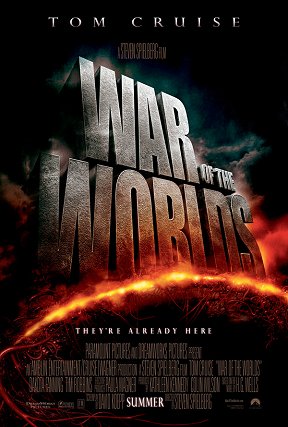
I asked Hines two or three times about when the film would be shown to critics, and each time he gave what sounded to me like an evasive answer. He later told me he’ll let me have an exclusive peek sometime in early March.
Here’s some verbatim excerpts from what Hines told me. I’m just running the quotes undoctored, not having time to double-check everything before my scheduled return to Santa Barbara early this afternoon:
“I’ve been wanting to make War of the Worlds since I was ten years old. We were going to make a present-day version but we had to abandon our plan after 9/11.”
[Note: I don’t know for a fact that Hines began his film in ’98, but he took out a trade ad announcing his project in the 5.7.01 issue of Daily Variety, timed for appearance during the Cannes Film Festival.]
“I’m a small independent coming out of nowhere. We’re clearly not part of the Hollywood machine. Obviously, Steven Spielberg doesn’t want to be seen as trailing in our footsteps. This is the first time ever in history in which a major studio, big-budget film will be following a smaller indie version of the same thing into the marketplace.
“We’re expecting to be trashed by critics, but my film is gorgeous. I cry every day at how well it’s coming together.
“We’re following the Wells book very closely, which partly involves using an old-fashioned idea know as story tension. The book begins with the initial landings, but the Martians don’t really show their hand until one third of the way in…but you know all the while that they’re going to emerge and start attacking, and that’s where the tension lies.”

Timothy Hines, apparently. (I haven’t met the guy or taken his photo personally.)
“I didn’t make it as an analogy to the Iraqi War, although, yes, it’s about occupiers and hubris. All through history invaders and conquerors have fallen prey to their own hubris. You see it again and again and again. Wells was protesting the Boer War with his book. He was saying Britain is going to fall one day, and it did…it was beaten by a little brown man wearing a loincloth.
“Paramount is trying to get people to compare our film with theirs on the basis of budget and special effects alone, but a satisfying film is about more than just that.
“That said, our effects are going to look as good as if not better than what you see on Star Trek, for instance. Our film, at its best, comes off as visually assured as The Matrix.”
SBIFF: The Return

Prior to the “Directors on Directing” panel at Santa Barbara’s Lobero theatre, on Saturday, 2.5.05, staged as part of the Santa Barbara Film Festival (l. to r.): the totally hidden head of Joel Schumacher (The Phantom of the Opera, Kevin Bacon (Loverboy), the partially hidden head of Terry George (Hotel Rwanda), Jeff Arch (Dave Barry’s Complete Guide to Guys ), Luis Mandoki, i.e., Mexico’s answer to Carrot Top (Voces Inocentes), Alejandro Amenabar (The Sea Inside), Michael Traeger (The Moguls), and producer-moderator Peter Guber.

(l. to r.): Bacon, Schumacher, Arch, George, Mandoki, Amenabar and Traeger.

Santa Barbara’s Haley Street looking east, State Street at the traffic light — Saturday, 2.5.05, 5:25 pm.

Mike “Mouse” McCoy (l.), pretty much the star of Dana Brown’s Dust to Glory, a rousing, fast-moving doc about the Baja 1000 race in November ’03, with Brown (r.) at an after-party at Soho, an upstairs bar just off State Street — Saturday, 2.5.05, 10:40 pm.
Thoroughbred
I have this notion that the Norman Jean Roy photo of Hilary Swank that appears on page 362 of the new Vanity Fair (as well as on a Sunset Strip billboard plugging this issue) is going to cinch Swank’s chances at winning the Best Actress Oscar.

Million Dollar Baby star Hilary Swank in 1936 Leni Reifenstahl mode, as seen on Sunset Strip billboard plugging current Oscar-themed “Hollywood” issue of Vanity Fair.
One look at this photo and you can’t help saying, “Wow…she’s on it.” If nothing else it’s a reminder of the intense physicality that Swank brought to her performance in Clint Eastwood’s boxing film.
A Swank triumph has been feeling like a strong likelihood anyway, but this photo feels like a closer of some kind. Or am I just floating on my own fizz?
Throat Session
A gala invitational screening of Randy Barbato and Fenton Bailey’s Inside Deep Throat (Universal, 2.11) happened Thursday night at Hollywood’s Arclight Dome theatre, followed by a discussion of some of the subjects raised by the film (social values, the legacy of pornography, etc.) by five prominent panelists.
Conservative talk-show host Dennis Prager brought about gasps from the mostly-liberal audience by saying he believed that damaging a child’s sense of sexual innocence was more emotionally harmful than exposing the same child to violence. He also advanced the notion of good violence (i.e., the shooting of evil Nazis) vs. bad violence.

After Thursday night’s screening of Inside Deep Throat, a discussion of sexual values by Democratic strategist/spokesperson Lawrence O’Donnell, author, filmmaker and Time critic Richard Schickel, author and syndicated columnist Arianna Huffington, conservative radio talk-show host Dennis Prager and Variety editor Peter Bart — 2.4.05, 9:25 pm at Hollywood’s Arclight Dome theatre.
Democratic spokesperson and campaign strategist Lawrence O’Donnell and Time magazine film critic Richard Schickel contended that no parent can keep his or her child in a state of idyllic innocence these days regarding sexual matters. Schickel said one needs to adopt an “existential, case-by-case, child-by-child” approach in dealing with these matters.
Moderator Peter Bart didn’t let audience members ask questions, but if he had I would have brought up the concept of good sex vs. bad sex, and why neither the film nor the panel had addressed the fundamental issue of how deeply depressing pornography is. The fact is that pornography envelops the viewer in the spiritual world of some very desperate and untalented people who are doing things that may seem hot at first, but after watching them for ten minutes or so constitute a total turn-off.

O’Donnell, Schickel, Huffington — 2.3.05, 9:40 pm at Hollywood’s Arclight Dome theatre.
I’ve always said that I would be a major porn fan if X-rated filmmakers would make their films look and feel like a 1960 Ingmar Bergman film — using moody, carefully- lighted black-and-white photography with someone of the calibre of Sven Nykvist serving as the director of photography, and using actresses like Bibi Anderson and Liv Ullman, and spoken in Swedish, of course.
I have never seen a single porno film shot in lustrous black-and-white. Has anyone? This alone indicates the skanky, donkey-like mentality of X-rated filmmakers, and their general unwillingness (inability?) to do anything other than shoot the same old boring crap.
Sharon’s Book
The first thing that got me about Sharon Waxman’s Rebels on the Backlot (Harper Entertainment) was its assurance. It’s a very smooth and soothing read.
Call me a plebian but I love inside-the-beltway books that deliver that massage-y, cruise-control, we-know-everything feeling(like Peter Biskind’s Down and Dirty Pictures and David Thomson’s The Whole Equation did) along with…you know, the other virtues.
The next thing that got me was a certain compassion for George Clooney and David O. Russell. Those poor guys…fine on their respective turfs, but put them together on the set of a physically difficult, hard-to-get-right movie like Three Kings and sparks of agitation are inevitable.

International Creative Management hotshot agent Robert Newman (i.e., “the hip indie guy”), Rebels on the Backlot author and New York Times Hollywood beat Sharon Waxman, and producer Don Murphy (From Hell, Permanent Midnight) at beginning of party for Waxman’s just-released book at Book Soup, an oasis of literacy in West Hollywood — 2.3.05, 7:05 pm.
Waxman delivers a better, more convincing story of their fight during the making of this 1999 film than anything I’ve read or heard anywhere else.
What was the hassle about? Russell, King’s director, told Clooney before filming began that he needed to break a lot of bad acting “habits,” and that he wanted Clooney “to be very still” in his role. When Kings began rolling, Russell kept on Clooney to cut down on the Clooney-isms, in response to which the TV-series veteran repeatedly “bristled.”
“Their relationship seemed doomed,†Waxman writes. Clooney “felt undermined by his director and labored under the burden of knowing he was Russell’s last choice…this led to disastrous consequences.â€
Out-there guys like Russell are never a day at the beach, but David O. was only trying to bring about the aesthetically right thing. Clooney does have a lot of bad habits. That cool-smug-guy thing that he employs all the time…don’t get me started. Russell may have been the provocateur in the breakdown of their working relationship, but Clooney needed — needs — what he was trying to dispense.
It was reported two or three months ago that Russell was upset with Waxman for making him seem slightly looney-tunes in her Times profile of his methods in the making of I Heart Huckabees. Many people agreed with him to some extent, but Waxman’s book has balanced the ledger sheet. To my eyes, she’s portrayed Russell as the most doggedly exacting and perceptive high-profile director in town.
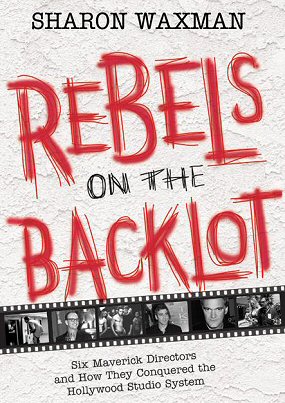
Rebels on the Backlot is essentially a story about the adventures of six cool-cat Gen-X writer-directors — the leaders of the pack who defined a certain accomplished, provocative, well-funded hipness over the least ten years: Russell, Spike Jonze, Quentin Tarantino, David Fincher, Steven Soderbergh and Paul Thomas Anderson.
“I wanted to know about who they were,” Waxman told a New York Observer writer last week. “When you are talking about films that are so personal in their vision, you can’t help but wonder from what mind or personality [those pieces of work] sprang.”
Waxman was in Park City covering the Sundance Film Festival for the New York Times, for which she handles the Hollywood beat. I could have arranged some face-time with her myself (which would have made the piece you’re reading a better one), but the festival kept shoving me around and throwing me off my game.
I’ve run into these directors at one time or another, mostly in the course of doing this or that story, but I’ve never gotten to know them. Not like I know Wes Anderson, I mean. (Hey…how come Waxman didn’t include him in the book? Focus on seven directors rather than seven, etc. Wes is as important as any of these other guys, I feel.)
Another thing that caused me to find Waxman’s book delightful is that it conveys facts that significantly add to my understanding of what these filmmakers are about…what’s driven them, scared them, briefly defeated them, inspired them.
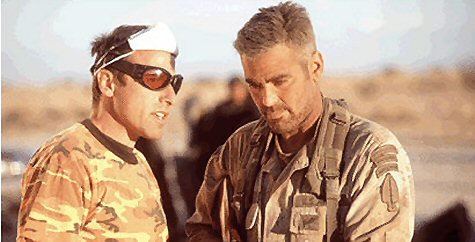
Three Kings director David O. Russell, star George Clooney during the problematic (some would say tumultuous) shooting.
I was shocked, shocked to read that Quentin Tarantino’s background was not that of a white-trash, fast-food-eating Tennessee kid from a broken home, but one that was more or less upper middle-class.
There’s a passage about Tarantino and Steven Soderbergh’s personal lives that I find fascinating. Partly because this is exactly the kind of passage that an aggressive and brilliant male writer would never include in a book about Hollywood filmmakers. It’s mildly cool nonetheless that Waxman has shown her colors in this fashion.
Tarantino nor Soderbergh “had trouble with intimacy” and “seemed [unable] to sustain relationships with the opposite sex,” she writes.
There was “a quiet woman” who was part of Tarantino’s life about 12 or 14 years ago named Grace Lovelace “who remains -– according to many who know [Tarantino] — the true love of his life.” She reports that after he became famous Tarantino became “a serial dater of his leading ladies or his producer or the starlet of the moment.”
This is nothing compared to what she does to Soderbergh. She suggests that he may be James Spader in sex,lies and videotape, “the articulate intellectual dealing with emotions in distant, muted ways,” a guy, like Spader’s “Graham” character, “who could enjoy sex with women only through the distance of the camera eye.”
To varying degrees, all the directors in Waxman’s book come off as fickle, egoistic, thin-skinned, prickly, brusque. This is nothing strange, of course. There’s always seemed to be a basic disconnect between submissive, mild-mannered, go-along behavior and being possessed of exceptional talent, smarts and vision. I’ve noticed this time and again, and it’s no big deal.

Some day, somehow, someone will discover on what set this shot of Steven Soderbergh was taken. My guess is The Limey.
A strong director can’t be a strong director without being tough and flinty and at times unyielding. It’s a tough game that requires toughness and tough hides. I respect this, and have no problem with anyone who wants to try and bitch-slap me (so to speak) or give me an argument of some kind about something I’ve written. As long as they’re straight about it, fine.
A week and a half ago Soderbergh lectured me during the Inside Deep Throat Sundance party. It was about my writing a couple of years ago that George Clooney’s Confessions of a Dangerous Mind seemed strongly influenced by Soderbergh-ian visual stylings, which, in his view, diminished Clooney’s rep by suggesting he had no visual chops or chutzpah of his own.
I wish more people in this town would play it like Soderbergh and just walk right up and say it to my face.
It may sound like a vague put-down to call Rebels a great airport lounge or a coast-to-coast read, but this book is friendly. I read it cover to cover, but it’s structured and titled in such a way that you can just drop into any chapter and go to town. I guess what I’m really saying is that people with attention deficit disorder will have no problem with it.
Monochrome Porn
“Regarding your comment about there being no black-and-white pornography: I’ve seen it done by Andrew Blake (http://www.andrewblake.com). He actually uses it quite a bit. His stuff is really top notch — all shot on film, excellent lighting and the best looking girls in porn. The only problem is that he’s really gotten into the bondage stuff, which does nothing for me.” — Ross Williams, writer-
director (http://eraticate.com)
Truce Already
“I liked your two stories about the competing Christmas Truce of 1914 projects. I thought you might be amused to know that there is a virtual train wreck of Christmas Truce projects in the works.
“Besides the Vadim Perelman’s The Truce, Paul Weitz’s Silent Night and the German-French co-production of Joyeux Noel costarring Diane Kurger (now in the can and slated for a Xmas ’05 release), there are also:
“(1) Truce: 1914 — A British production ramping up for a 2005 start to be helmed by Peter Shillingford, a director known for his IMAX work. Brian Cox, Til Schweiger and Jonny Lee Miller are attached. (http://www.imdb.com/name/nm1466053)
“(2) Light of Peace — A film being produced by Marc Rosco of Electric Entertainment. Roland Emmerich was attached to direct.
“(3) …and a short film called Offside (produced by pop singer Michael Bolton) that premiered at the 2001 Sundance Film Festival.
“And then there is my own short film, also called The Truce, which won a Student Emmy and played at the 2001 Hamptons Film Festival (while Offside screened in an adjacent theater).
“I can’t accuse anyone of ripping me off; I was still shooting while Offside was in post. (http://www.thetruce.com and http://www.imdb.com/title/tt0289587/ combined).
“I had my own idea for a Christmas truce feature where the German and British soldiers team up to destroy an asteroid heading towards a crash collision with Earth, but none of the studios bit…alas.” — Eric Rolnick












